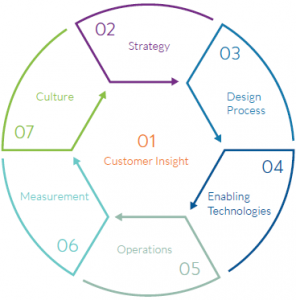The first of the seven customer experience (CX) dimensions discussed in Perficient Digital’s CX strategy guide is Customer Insight. As I’ve discussed in the previous posts in the series, in life sciences, “customer” means many things: patient, physician, clinical site, clinical subject, research partner, regulatory agency, vendor, and even employee.
To provide each of these groups with a differentiating CX, you need to really understand who they are, what they want and need, and what makes them tick. That’s why the first dimension of CX is Customer Insight, and why the other six dimensions revolve around it:
Data is King
By gathering customer insight through research and data, you are able to understand your customers’ needs and to establish goals that will lead to new and better experiences for them. It is critical to speak with your most valued customers to understand their expectations and how you currently measure up. You need to know which touchpoints and communication channels are involved in their interactions with you and how satisfied they are with those interactions.
An effective CX plan addresses each of the topics below, and includes data that can be analyzed to clearly understand the current context of your relationship:
- Customer personas that include a ‘most important tasks’ ranking
- Customer journey maps that have been verified with data and customer research
- Insight into the role, importance, and level of customer satisfaction with every touch point in their journey
- Understanding of how mobile devices are used to interact with your company
- Understanding of CX satisfaction today, with the ability to drill down into the five to eight key drivers
- Understanding of customer loyalty strength, including advocacy
- A system to collect customer feedback and use it to drive CX innovation and improvements
An Untapped Gold Mine
To truly understand your customers, it is also important to gather information from your customer-facing employees. Remember that, in life sciences, “customers” are not just the general public. Depending on the relationship you are trying to strengthen, your customer-facing employees will be different: If you are focused on principal investigators, your customer-facing employees are your clinical operations staff. If you are focused on regulatory agencies, your customer-facing employees are your regulatory affairs staff. And so on.
These employees are a means to understanding what barriers exist between your customers (however you are defining them) and the ideal experience. They have the day-to-day experience and insight into your company’s operational or technological barriers, and are often a great source of “quick wins.”
Best Practice: Create a Detailed Customer Journey Map
“Customer Journey” is quite the buzzword these days, but I’m not sure how well-understood it is outside of marketing departments, so here’s a basic definition: a visual depiction of each of the touchpoints your customers have with your organization. I’ve seen maps with different numbers of steps and with different labels for each step, but the following is a good template:
- Awareness: How do your customers become aware of your organization, your products, your clinical research, etc.?
- Discovery: How do they learn more about you and what you do and/or produce?
- Attraction: What draws them in, gets them excited, and makes them want to engage with you?
- Interaction: When, where, and how do they interact with you?
- Participation: What makes them pull the trigger and become an actual customer (e.g., principal investigator, research partner, clinical subject, prescribing physician, patient, employee)?
- Cultivation: What makes them continue to work with you or for you?
- Advocacy: What turns them into a loyal advocate for your organization?
A good customer journey map illustrates every interaction a customer makes while completing a transaction. A best-in-class map incorporates data and customer input to identify pain points and the best ways to eliminate them.
In the next post, I’ll discuss the second dimension of CX: Strategy.


